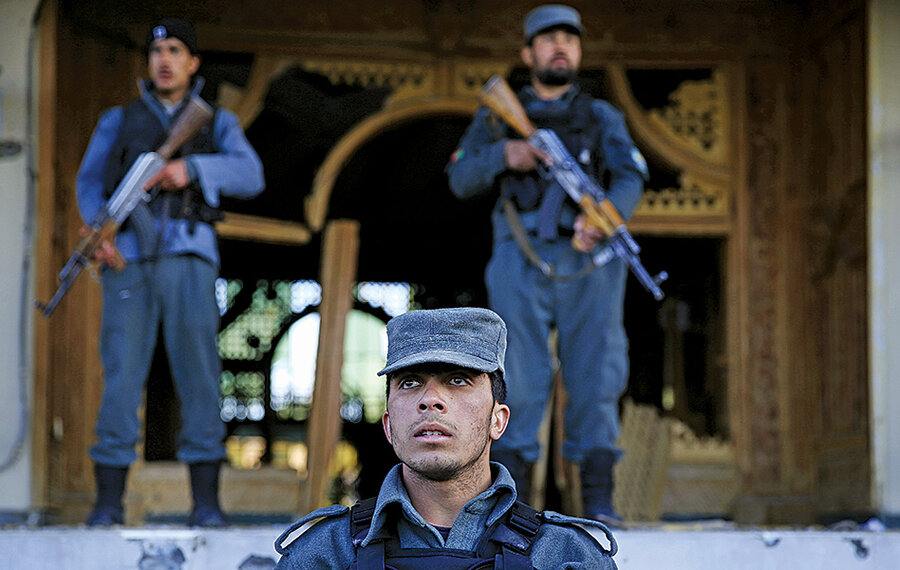As election looms, Afghanistan's history offers lessons – and hope
Loading...
On Feb. 15, 1989, the last Soviet tank rolled over the Amu River, which marks the frontier between Afghanistan and what is now Uzbekistan.
A decade-long slog to impose a Soviet vision on Afghanistan was over. The Afghan state immediately collapsed, starting a civil war that ended in the Taliban's seizure of Kabul in 1996 and the murder of the man Moscow left in charge.
Correct? Not entirely.
That version of events is a common misconception. Understanding why Afghanistan collapsed 25 years ago contains lessons, and even a little hope, about what comes next as Afghans elect a new president April 5 and the United States and NATO edge toward the withdrawal of troops by the end of the year.
While the sporadic violence currently roiling the country is likely to continue, a triumphant Taliban march on the capital city of Kabul – or even their old stronghold of Kandahar – is unlikely. In fact, the kind of dealmaking among Afghans that could promote stability might grow easier – particularly with the foreign troop presence, a major recruiting tool for the Taliban, either gone or reduced to a fraction of its heights.
Afghanistan, 1989
When Soviet leader Mikhail Gorbachev ordered the withdrawal of troops from the mountainous region he called the Soviet Union's "bleeding wound," the Afghan regime he left behind did not immediately self-destruct.
Then-Afghan leader Mohammad Najibullah was well funded and armed by his Soviet backers. He had little trouble keeping the Pakistan and US-backed mujahideen – a patchwork of ethnically based militias and Islamist groups that fought the Soviets – in the countryside and on the country's political fringes.
A spring offensive by the mujahideen in the eastern city of Jalalabad in 1989 was handily defeated by Mr. Najibullah's troops and caused splintering in the insurgency's ranks, with some commanders cutting peace deals with the central government in the wake of defeat.
Najibullah's resilience was not surprising given Afghanistan's history, says Thomas Barfield, a Boston University anthropologist who has studied Afghanistan since the 1970s and sees no reason why the long-term pattern won't continue.
"Gorbachev didn't give Najibullah's government more than six months," says Mr. Barfield. "But he outsurvived the Soviet Union, and I think if [the Soviet Union] hadn't collapsed that we might be going to Najibullah's 20th anniversary in power right now."
But the Soviet Union did implode at the end of 1991, and with its fall the flow of cash and arms to the Afghan government dried up. Najibullah held power until April 1992. He then lived in the United Nations compound in Kabul until the city was overrun in 1996. Then the Taliban came for him, dragging him through the streets before hanging him and his brother from a traffic light in the center of town.
Afghanistan today
The Soviet story points to two lessons that resonate in Afghanistan today: the fate of Afghan leaders installed by foreign armies, and the importance of foreign aid.
President Hamid Karzai, who was installed by NATO, is prevented by term limits from extending his 12-year run as Afghanistan's leader. But his influence is far from diluted – and he's become a far from reliable Western client in recent years.
Mr. Karzai has said NATO is a greater threat to Afghanistan than the Taliban, and dismissed as the work of foreigners the rampant corruption that has drained billions in aid from the country; this month he joined Syria and Venezuela in supporting Russia's annexation of Ukraine's Crimean Peninsula.
Most crucially, he has refused to sign a so-called bilateral security agreement (BSA) with the US that would allow 8,000 to 12,000 American forces to remain in the country beyond the end of this year and would maintain the high international aid flows on which Afghanistan's government and economy rely. (In 2010, the World Bank estimated total foreign aid to Afghanistan at $15.7 billion – equal to about 98 percent of Afghan gross domestic product that year. Around 60 percent of Afghanistan's spending is covered by foreigners, as is Afghanistan's huge current account deficit.)
The US has threatened a withdrawal of funds if the deal isn't signed. But Karzai has refused to budge, perhaps mindful of his status as a US-installed Afghan leader and the past fate of Afghan leaders who owe their standing to outsiders. Few of them have been fortunate enough to make it into exile; most of them have been killed.
When Karzai convened a loya jirga, a meeting of tribal notables and politicians, last year, hoping they would agree with his contention that signing the BSA should be left to his successors, they roundly disagreed. Still he refused to sign.
"He expected [the jirga] to give him some breathing room, and they came out with the opposite conclusion," says Stephen Saideman, a professor of international affairs at Canada's Carleton University and coauthor of "NATO and Afghanistan: Fighting Together, Fighting Alone."
Most people who watch Afghanistan doubt that the US will be kicked out of the country at the end of the year. Afghanistan's next president – there are currently four front-runners, and who will win is anyone's guess – will have the weight of pressing financial needs and a loya jirga mandate arguing for his signature.
"There is, I think, a leverage thing going on here, which is that the US is saying that if you want our money, you're going to let us stick around," Mr. Saideman says. "That's being seen by most people on the ground as a credible threat, [and] everything we've heard out of Afghanistan is that they want the troops and the money to stay."
Economic and development aid
That leads to the second lesson, in Barfield's eyes: A withdrawal of foreign military force has rarely if ever led to the downfall of an Afghan ruling arrangement. But a withdrawal of financial and diplomatic support – whether by the British or the Russians – has often been fatal.
Even if the US is given permission to stay in Afghanistan, its military presence will be underwhelming. The US troop count peaked at 100,000 in 2011, leading a total NATO force of 140,000. Fewer than 40,000 US troops remain today, and the commander of US and NATO forces in Afghanistan is looking for only 8,000 to 12,000 troops to remain.
Already the bulk of the fighting is done by the Afghan National Army and National Police, which make up more than 90 percent of total coalition troop strength and conduct more than 95 percent of all missions. That's reflected in the surge of casualties among Afghan forces. A total of 1,236 Afghan soldiers and 3,290 policemen were killed from 2007 through 2010. Since the end of 2010 at least 8,000 Afghan soldiers and police have been killed, a 75 percent increase.
Yet there are signs that US funding will not remain assured for the long term. Congress allocated $85 billion in military spending for this year, but just $1.1 billion in civilian assistance – half the $2.1 billion the Obama administration had requested.
That cut reflected lawmaker anger at Karzai's refusal to sign the BSA – and voter unease with the vast sums spent in Afghanistan, large portions of which have been lost to corruption and incompetence.
Diminished expectations
Amid the ongoing struggles in Afghanistan, are there any signs of hope? The US has dramatically pared down its expectations for the country.
Gone are the days when American officials predicted rapid economic growth for Afghanistan and a truly functioning democracy. In his March 12 testimony to the Senate Armed Services Committee, Gen. Joseph Dunford, the commander of US and NATO forces in Afghanistan, defined "winning" in Afghanistan in the following terms: an "operationally ineffective Al Qaeda," capable and sustainable Afghan security forces, a successful election of a new president in the eyes of most Afghans, and a "constructive Afghanistan-Pakistan military to military relationship."
Barfield argues that it's one thing for insurgents to drive out foreign militaries with unconventional hit-and-run tactics and their vastly greater understanding of local cultures and communities; it's quite something else to build an army that can overthrow an Afghan government that has a wealthy foreign patron.
In that regard, there's some hope. Not that violence in Afghanistan will end soon, or that the Taliban and the conditions that spawned them will fade from the country's political life. Or that opium exports will cease to be the second most important element in the Afghan economy after international aid.
But there is hope that the country will hold together, and perhaps even get a bit better.
"Every ruler put in by an invading foreign army [in Afghanistan] has failed because they've been weak personalities, and every one put in by a withdrawing foreign army has succeeded because they've put in, or allowed, stronger personalities," Barfield says.
He isn't willing to guarantee things will get better – much depends on whether many of the Afghan leaders who have prospered in the past decade will share their wealth through building and extending patronage networks in the country, and how many, as he puts it, "are going to take their dual passports and the Emirates flight out of Kabul and live on their ill-gotten gains in Dubai."
But the Taliban is far weaker than the mujahideen was in 1989, and its predecessors failed at moving beyond the countryside until the foreign money dried up.
Through 2015 at least, assuming the BSA is signed, the money seems assured.








